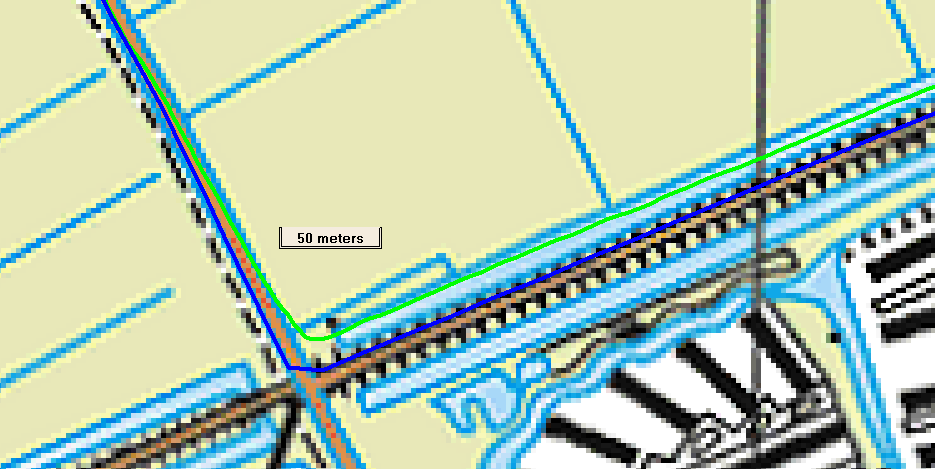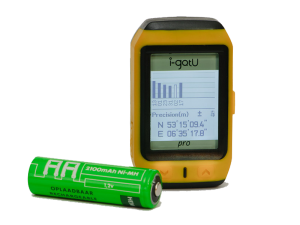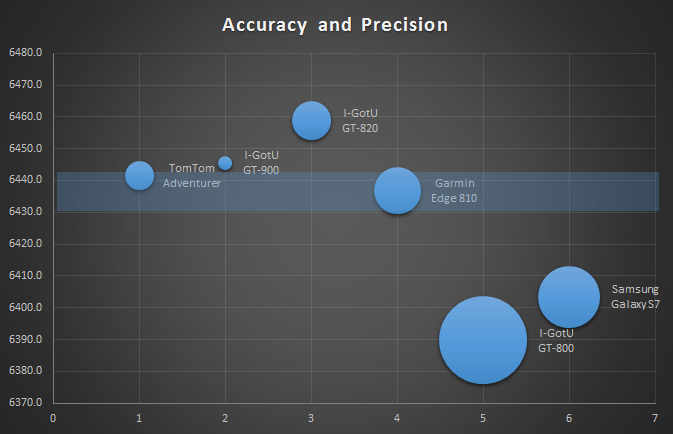01-2018 TomTom watches compared
For developing software I use three TomTom watches as guinea pig for testing

I did two runs with all three watches on two arms. Next table compares the tracked distance as calculated by Oziexplorer on the raw GPS coordinates.
| Watch | Run 1 | Run 2 |
| Multisports (red) | 13.90 km | 11.27 km |
| Runner (blue) | 13.90 km | 11.32 km |
| Adventurer (green) | 14.01 km | 11.30 km |
Difference between the watches is well within 1%.


So the watches are quite comparable with respect to accuracy (maybe the Runner is least accurate measured over 4 runs with deviations up to 18 m, but not enough statistical evidence here).
03-2017: trueness and precision; new: the TomTom Adventurer
The contestants
- Garmin Edge 810
- High-end bicylce GPS, implementing full routing and maps.
- I-GotU GT-800 Pro
- One of my first GPSses
- I-GotU GT-820 Pro
- Successor of the GT-800, wrist worn, for running
- I-GotU GT-900 Pro
- Successor of the GT-800, bike mounted, for cyling
- TomTom Adventurer
- GPS Watch
- Samsung Galaxy S7
- Smart phone, trip log with Oziexplorer
Test: six laps of 4 mile
GPSses were taken on a bicycle trip on a know track of 4 Mile. The GT-820, GT-900, Edge 810 and the Adventurer logged the trip at 1 second interval, the GT-800 at a 5 second interval. The S7 with Oziexplorer logged the trip at an irregular interval. Conditions: light clouds, track partly along the forest boundary, no folliage on the trees.
The GT-820 and Edge 810 were mounted on the steeringrod, GT-900 and Adventurer were wrist-worn. They had probably the most clear view on the sky. The GT-800 was worn in my backpocket, the S7 in my breast pocket.
Six laps were cycled. For each lap the GPS coordinate that was nearest to the start was assumed as the start of the lap. Similar, the nearest coordinate to the finish was adopted as end of the lap. Each lap was downloaded and imported in Excel. For each lap the distance was calculated using the haversine formula. Height was not taken into account, since the track was fairly flat. For each GPS the average lap was calculated and the standard deviation over the 6 laps.
Result
Next table shows the measurements. Average and standard deviation are plotted in the graph.

Trueness or accuracy defines how well the measured distance corresponds to the real distance, in casu 4 Mile or 6436 m. Precision is a measure for the spread. See also the excellent site fellrnr.com on GPS accuracy.
All GPSes were quite accurate. Largest deviation was measured by the GT-800, but the deviation was only -1.1%, Apparantly the Edge 810 was the most accurate on the average, followed by the Adventurer. The S7 and GT-800 were on the low side, but this may result from the fact the log interval was longer compared to the other four, resulting in ‘cutting corners’.
The GT-900 was the most precise, with a standard deviation of 0.8 m, followed by the Adventurer. Given the fact that the Adventurer has the most advanced GPS chipset (SIRFstar V, GPS+Glonass), the GT-900 (SIRFstarIV, GPS) performed remarkably well on precision. The GT-800 (SIRFstartIII) showed quite some deviation of the logged track, resulting in the least precision.
Note: The accuracy with which the lap was layed out on the road is not known. In the graph we assumed a reasonable error of +/- 5 m, shown as the band around 6436 m.
A remarkable finding was that the clock of the Edge 810 appeared to be ahead of time 11-15 seconds, 12 seconds average. The Edge 810 clock however seemed to be synchronized (less than 1 second difference with my time server; GPSses normally synchronize to the GPS time). Apparently the logging of coordinates lags the actual position. This is what I’ve seen before on this device: though I had stopped, the arrow on the screen proceeded to my actual position.
10-2016: 3 GPSses compared; new: the Garmin Edge 810
The contestants
- Garmin Edge 810
- High-end bicylce GPS, implementing full routing and maps.
- I-GotU GT-820 Pro
- Successor of the GT-800, wrist worn, for running
- I-GotU GT-900 Pro
- Successor of the GT-800, bike mounted, for cyling
Test: Cycle trip, 90 km
I did a 90 km cycle trip. The GT-900 was on my wrist, the Garmin Edge 810 on the steering rod, 30 cm from my wrist. On another trip along about the same route, I cycled with the GT-920 on my steering rod. On both trips the sky was clear. I chose a route with a lot of forest. The GT-900 logged a point every 4 seconds, the Edge 810 every second.
The GT-900 did not show substantial deviation during the entire trip (say ~5 m max).
The GT-820 showed small deviation (~15 m) in the begining of the trip.
The Edge 810 seems to be cutting corners under foliage. Two examples are shown below. Because of this, the total logged trip was 89.1 km on the Edge 810, whereas the GT-900 logged 90.2 km, a deviation of -1.2%. I have seen the Edge 810 lagging the actual position: while I stopped, the pointer on the display still moved a few seconds.
I conclude that the I-GotUs perform quite well on accuracy. I am amazed that the Garmin does not perform better and seems to be the least accurate GPS of the three.


Another example comes from a short 7 km trip, without navigation (to rule out the device performance as the cause). What appears is that if trees are around (not even heavy foliage) the Edge 810 error increases (it happened on three occasions during this trip), whereas the I-GotU is not affected. In the picture below the cycle path on the dike is lined at both sides with thin but high trees. The deviation increases to ~15 m. During this trip the deviation of the Edge is not too bad, but still worse than the GT-900.

11-2011: 3 GPSses compared
The contestants
I did a comparison between 3 devices:
- Garmin GPSMAP 60CSx
- I own this GPS for some time. It is accurate and often used as reference. However, it is fairly large. I have to keep it in hand during running. It is based on the SirfIII chip and has a good antenna. It’s got all you can wish for: maps, airpressure altidude measurement, electronic compass, all kind of statistics, etc, etc. No longer deliverable.
- I-GotU GT-800 Pro
- Also SirfIII based. I bought it because it is smaller. It comes with a wrist strap. However, I find it uncomfortable wearing. Once the clip mechanism opened during a run and it fell of my arm. It’s got a simple 128×128 pixel display, presenting valuable information for the runner about speed and distance. It has even got a simple track overview. Predefined (uploaded) waypoints can be used for route following. It logs nice details for every trackpoint, like number of satellites and EHPE. Though not available from the suppliers software, U-gotMe can make it available for you :-D. The ‘Pro’ type has got an electronic compass and a pressure sensor. Price: ~120 euro

It records the track. Nicely priced at ~60 euro.
I set all three devices to log a trackpoint every 5 seconds.
Test 1: cycling downtown
I cycled down to work through the city having the i-gotU and Gisteq devices in my backpack. Both devices showed deviations of about 15 m. The i-gotU showed about 5 of such deviations, whereas the Gisteq showed only one.



Test 2: running
Main reason for buying these toys is I want to log my running trips. During a 25 km run I took the three devices with me: the Garmin in my hand (most optimal of course), the other devices in the pocket of my trousers, one left and one right (shielding satellite signal a bit more compared to the Garmin).
The Garmin performed excellent as expected. Both the Gisteq and I-GotU showed deviations so now and then. However the Gisteq deviations where more frequent and more severe.
Next picture shows the worst deviation of the Gisteq: Garmin in red, I-GotU in light blue, Gisteq in dark blue. There were high trees along the road.However they were thin and widly spaced. Max deviation is about 55 m.



Summarizing, several deviations of the Gisteq were seen between 30 and 40 meter. What appears is that the deviations take more time to restore. Worst deviation of the i-gotU: 28 m
That the i-gotU can do bad jobs is shown by the next picture of one of my runs. I had the device attached to my wrist. During 1.5 km it showed heavy deviations, sometimes between 60-80 m!!. Though there was some foliage above, this does not explain the error. Other parts of the trip with much heavier foliage did not show deviations. The dark blue lines represent my actual position. Rest of the trip (29 km) was quite good. Unfortunatelly I don’t have other reference measurements of the other devices on this trip…

Test 3: heavy forrest
I took the GPSers with me in the breast pockets of my jacket during a photo trip in heavy forrest.

At point 1 in next picture high fir trees were close to each other, hardly any blue sky visible (as shown above). I spent quite some time lying on my belly taking photos of mushrooms, the GPSers between me and the ground (kind of worst scenario I think…).
Next picture shows the result

What is apparent is that even the Garmin (red) shows some spread in the track points. The i-gotU shows a more heavy spread. Some points are missing, in that case it fills in the last known value. Still, these values
resembles the Garmin values quite neatly. The Gisteq however shows remarkable behaviour: apparently it does some nifty averaging, resulting in slick, continuous track at point 1. However it deviates up to 35 meter from the real track. No details are visible, like the ‘extension’ at the low edge of the track (I really took that track). Same effect occurs at point 2 in a much opener part of the forrest: Whereas the Garmin and I-GotU show the real path taken, the Gisteq apparently shows a ‘shortcut’. Next picture shows the spread of the track points in more detail.

Test 4: car
Having all three devices on my dashboard during a car trip resulted in a very straight track without deviations.


Conclusion
The Garmin, being an expensive, bulky, professional GPS is master of the game. The i-gotU shows some deviation with respect to the Garmin, but I was pleasantly surprised by the accuracy of the device. The Gisteq was slightly disappointing. I would have expected better results than the i-gotU since the chip is more sensitive and has more channels. It showed however more frequent deviations and more severe deviations than the i-gotU. Furthermore it showed some weird averaging effects resulting in slick but deviating tracks. So as a runner I would definitely choose the i-gotU based on the accuracy (and of course the display).

